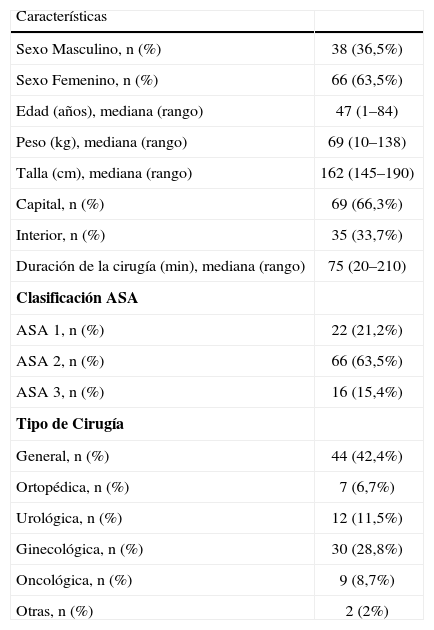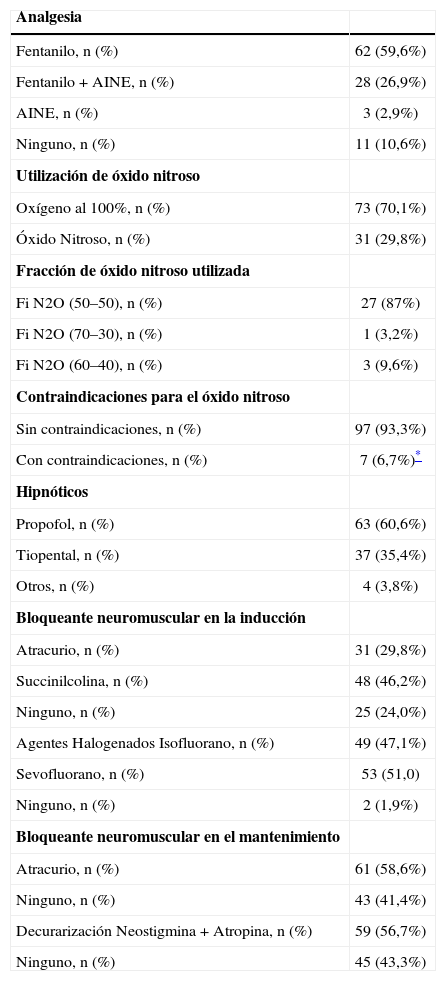El óxido nitroso (N2O) es un gas medicinal que ha sido utilizado en la práctica anestésica por más de un siglo y medio. La acumulación de evidencia de sus efectos adversos en comparación con el buen perfil de seguridad de los nuevos agentes anestésicos, ha determinado una reducción de su uso a nivel mundial.
ObjetivoDescribir la utilización y analizar la prescripción del N2O en la técnica anestésica en la República Oriental del Uruguay. Describir la utilización del resto de los fármacos de la anestesia general.
MétodosEl estudio se dividió en dos partes. La primera parte registró la utilización de N2O y de los otros fármacos en la anestesia general, mediante el análisis de las historias clínicas de una muestra de pacientes que recibieron tratamiento quirúrgico entre noviembre de 2007 y noviembre de 2008, en diversos centros asistenciales relevantes a nivel nacional. La segunda parte analizó la prescripción del N2O en anestesia general, mediante una encuesta voluntaria a 80 médicos anestesiólogos que se encontraban trabajando en el primer semestre del 2008 a nivel nacional.
ResultadosSe incluyeron 104 pacientes y 80 anestesiólogos en el estudio. El 29,8% (n=31) de los pacientes recibieron N2O durante la anestesia. El 77,5% de los anestesiólogos (n=62) respondieron que lo habían utilizado en el último semestre. El 50% de los anestesiólogos (n=9) señalaron no utilizar N2O por falta de disponibilidad del gas y el otro 50% (n=9) señalaron el riesgo de producir náuseas y/o vómitos postoperatorios (n=6) y/o el disponer de mejores opciones terapéuticas (n=9).
ConclusiónEl presente estudio muestra que el N2O es un fármaco poco utilizado en la práctica anestésica habitual y que presenta una tendencia a continuar reduciendo su consumo en el Uruguay.
Nitrous oxide (N2O) is a medicinal gas that has been used for anesthesia for over a century and a half. As evidence of the adverse effects of N2O have been contrasted with the good safety profiles of new anesthetic agents, use of the older gas has declined.
ObjectiveTo describe and analyze the use of N2O for anesthesia in the Eastern Republic of Uruguay. To describe the use of other drugs for general anesthesia.
MethodsThe study had 2 phases. In the first phase, information on the use of N2O and other drugs for general anesthesia was obtained from the medical records of a sample of patients who underwent surgery between November 2007 and November 2008 at nationally important hospitals. In the second phase 80 physician anesthesiologists were surveyed to obtain information on their reported use of N2O for general anesthesia. The respondents were found working during the first half of 2008.
ResultsA total of 104 patients' records were read and 80 anesthesiologists were surveyed. We found that 31 (29.8%) patients received N2O during anesthesia. The survey showed that 62 (77.5%) of the anesthesiologists had used N2O in the last 6 months. Nine (50%) of the anesthesiologists who had not used N2O said their reason was that it was unavailable. The other 9 referred either to the risk of postoperative nausea and/or vomiting (n=6) or the fact of having better alternatives (n=9).
ConclusionThis study shows that N2O is little used in current anesthesia practice. The tendency in Uruguay continues to be toward declining use.
Artículo
Comprando el artículo el PDF del mismo podrá ser descargado
Precio 19,34 €
Comprar ahora











